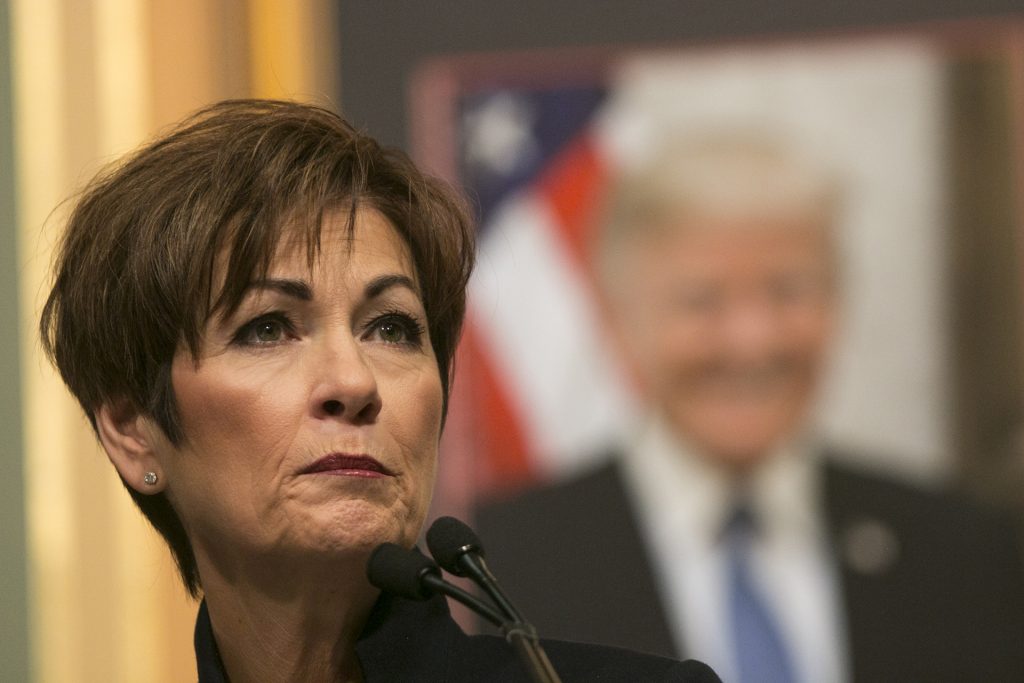Weigel: Will Iowa stay ruby red Republican? Probably.
There has been much talk of a ‘blue wave’ in national politics. However, if we look more locally at Iowa, there are signs that Iowa could remain under ruby red Republican control.
Iowa Gov. Kim Reynolds speaks during her first Condition of the State address in the Iowa State Capitol in Des Moines on Tuesday, Jan. 9, 2018. Reynolds took over the governor office in May 2017.
October 24, 2018
As colleague Collen Mahoney wrote a couple months ago, local elections do not always align with national sentiments. Thus, while many polls and campaign-finance reports indicate November’s midterm election may be a blue wave, if we look on a more local level, this may not necessarily be the case.
In the nomenclature of election forecasting, a scenario such as the above mentioned possibility is called an ecological fallacy. That simply means that what is true at one level of analysis is not true at another level of analysis.
In this case, it would mean that even if there is a blue wave at the aggregate (national) level, at the more local (state) level, there could quite possibly not be a blue wave.
Why might there not be a blue wave in Iowa? Well, for starters, Iowa is ruby red. That is to say, the state is dominated by Republicans. Gov. Kim Reynolds is a Republican, both U.S. senators are Republican, and three of the four U.S. House districts are led by Republicans. Not to mention, both the Iowa House and Iowa Senate are controlled by Republicans, and four of the five state-level executive offices (secretaries of state and of agriculture, treasurer, and auditor) are held by Republicans. This all goes to say that Iowa is largely run by Republicans.
And given the incumbency advantage, the Republicans in office will be tough to beat.
Nonetheless, if we look at polling, it would seem that Democrats could win the day in Iowa. According to a meta-analysis by 538.com, Democrats are heavily favored to retain Iowa’s 2nd Congressional District and capture the 1st District while narrowly claiming the 3rd District.
But in 2016, Democrats were also favored to win Iowa’s 1st and 3rd Districts, only to see both incumbent Republicans retain both. And despite Democrats’ overall nationwide money advantage, in Iowa, the Democrats and Republicans are remarkably comparable in regards to money.
RELATED: Mahoney: Iowa sees federal, state offices differently in the 2018 election
Additionally, 538’s meta-analysis of the governor’s race gives Fred Hubbell (D) an 85 percent chance to beat Reynolds (R). This is a bit surprising considering that 1) the most recent polling data gave Hubbell just a 2-point lead with a polling margin of error of 4 points, 2) Reynolds is an incumbent, 3) the state has a $127 million budget surplus, and 4) Iowa’s unemployment rate is the second lowest in the nation. Moreover, the most recent campaign finance reports reveal that both candidates have nearly the same amount of cash on hand heading down the homestretch.
Last, when we look at the Iowa Legislature, the prospects of Democrats taking control of either the House or Senate are bleak. With just 25 of the 50 seats up this election cycle, Republicans currently hold a 29-20 advantage (1 seat held by an independent) in the Senate. And in the House, Republicans currently hold 58-41 advantage (1 vacant seat). It would take a massive blue wave for Democrats to flip enough seats to gain control of the Senate, but claiming the House is possible with all 100 seats up for election.
Therefore, putting this all together, it appears that talk of a blue wave through Iowa may need to be tempered for a few reasons. First, Iowa is dominated by Republicans right now and incumbents are tough to beat. Second, although national funding and polling indicators point toward Democratic success, the metrics in Iowa aren’t as blue-tinged. And third, Iowa’s economy is booming with amazingly low unemployment numbers and a budget surplus.
Perhaps Iowa will lose some of its red luster come the morning of Nov. 7. It might become a bit more blue, but chances are red will still run deep through Iowa post-midterm elections.







